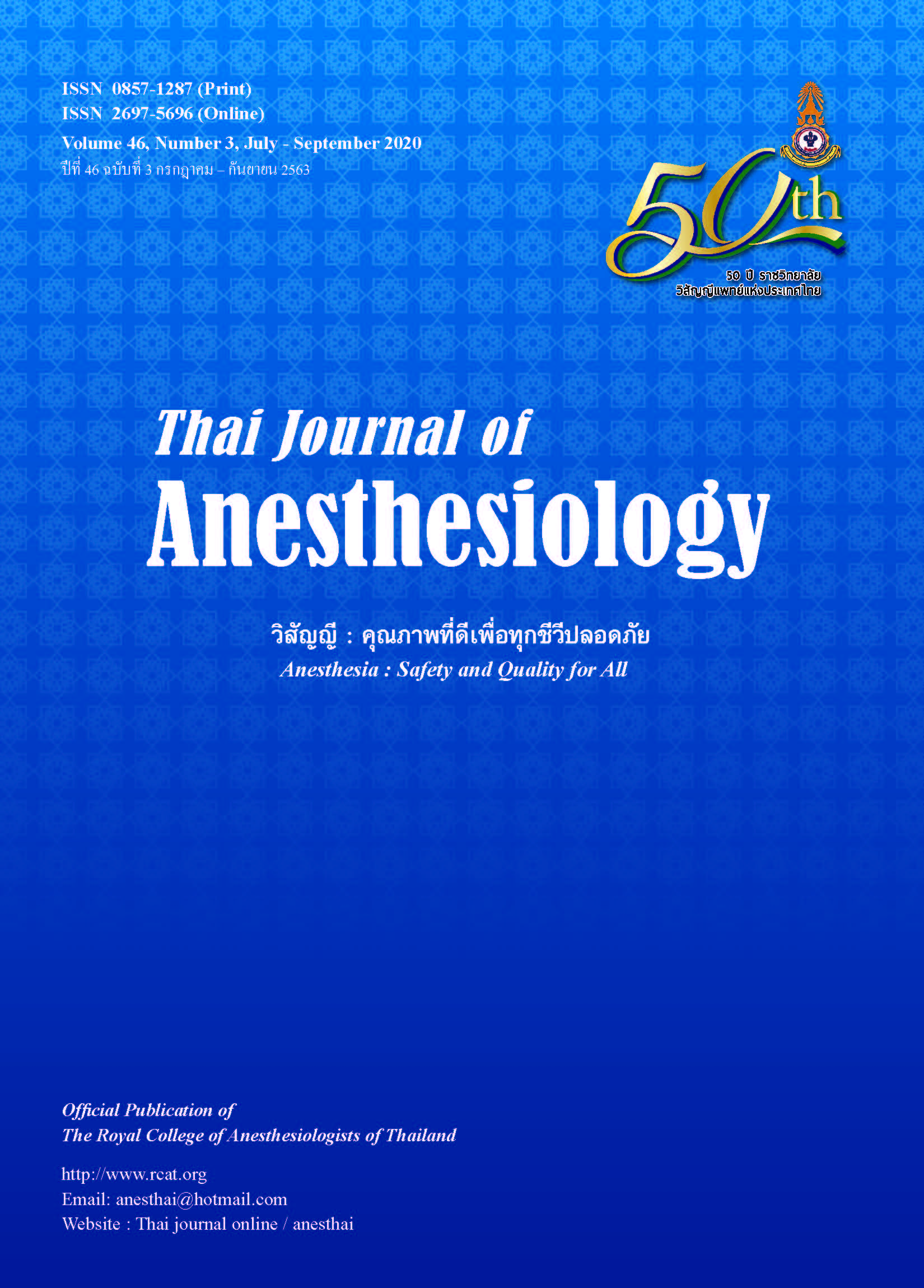Optimal Postanesthesia Care Time in Pediatric Undergoing Eye Examination under Anesthesia
Main Article Content
Abstract
Background: Two principles criterion that include Criteria
Based Discharge (CBD) and Time Based Discharged
(TBD), have been used for evaluating patient before
discharging them safely from PACU. Both criterions must
be met as an anesthesia department’s policy, which spend
at least one hour to complete these actions. However,
many studies found the discrepancy of time using CBD
and TBD in order to reduce PACU congestion in particular
type of anesthesia and surgery. Therefore, an average
PACU time compare between CBD and TBD, an also
associated factors that caused prolong PACU time and
complications were investigated in pediatric patients
underwent eye examination under anesthesia.
Method: This was a retrospective study, and 223 medical
records of pediatric outpatients who underwent eye
examination under anesthesia were included. The data
were collected including; patient’s characteristic, time to
meet PACU discharge criteria (CBD) using Modified
Aldrete Score and Post Anesthesia Discharge Scoring
System (PADSS), Time Based discharge (TBD) and
complications. Univariate and multivariate statistical anaylsis were used for comparing various parameters between
CBD and TBD.
Result: Our study found the mean CBD time of 34.08+14.4
minutes and the mean TBD time of 60+0.87 minutes with
P-value= 0.000. Female gender was slower recovery than
male and no severe postoperative complications were
evidence.
Conclusion: Criteria Based Discharge is an effective and
safe method to discharge pediatric outpatient who
undergoing eye examination under anesthesia from PACU
as a result of decreasing time spends in PACU and
manage PACU resource effectively
Article Details
References
measuring recovery following general anaesthesia. Can
Anesth Soc J 1978;25:4-6.
2. Aldrete JA, Kroulik D. A postanesthetic recovery score.
Anesth Analg 1970;49:924-34.
3. Aldrete JA. The post-anesthesia recovery score revisited.
J Clin Anesth 1995;7:89-91.
4. White PF, Song D. New criteria for fast-tracking after out
patient anesthesia: a comparison with modified Aldrete’
scoring system. Anesth Analg 1999;88:1069-72.
5. Song D, Chung F, Ronayne M, Ward B, Yogendran S, Sibbick
C. Fast-tracking (bypassing the PACU) does not reduce
nursing workload after ambulatory surgery. Br J Anaesth
2004;93:768-74.
6. White PF, Rawal S, Nguyen J, Watkins A. PACU fast-tracking:
an alternative to “bypassing” the PACU for facilitating the
recovery process after ambulatory surgery. J Perianesth Nurs
2003;18:247-53.
7. Chung F. Are discharge criteria changing? J Clin Anesth
1993;5:64S-8S.
8. Chung F, Chan V, Ong D. A post-anesthetic discharge
scoring system for home readiness after ambulatory surgery.
J Clin Anesth 1995;7:500-6.
9. Armstrong J, Forrest H, Crawford MW. A prospective
observational study comparing a physiological scoring
system with time-based discharge criteria in pediatric
ambulatory surgical patients. Can J Anesth 2015;62:1082-8.
10. Jain A, Muralidhar V, Aneja S, Sharma AK. A prospective
observational study comparing criteria-based discharge
method with traditional time-based discharge method for
discharging patients from post-anaesthesia care unit
undergoing ambulatory or outpatient minor surgeries under
general anesthesia. Indian J Anaesth 2018;62:61-5.
11. Awad IT, Chung F. Factors affecting recovery and discharge
following ambulatory surgery. Can J Anesth 2006;53:858-72.


